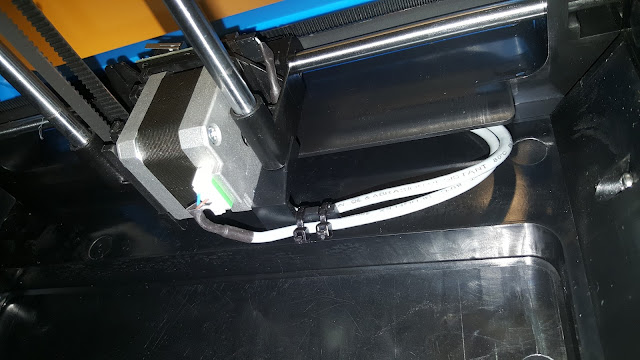For this test we're going to look at dimensional accuracy right out of the box. The USB Stick comes with the 20mm Box but you will have to put it into the Flashforge Flashprint Slicer to make it printable.
The first thing I noticed was the slightly longer boot up time. A couple seconds more but it still makes the boot up sound for you.
The display is updated and shows a small picture of what you're printing plus it has a temperature signal on the top right that indicates when the nozzle is hot.
The first thing I did was level the bed plate. The leveling aid is a pain to a lot of people but I've always had luck with it. The high pitch beep isn't there any more when you level. It's a different kind of beep and not as annoying. Leveling is not any faster and is identical to the Finder.
Operation was smooth and quieter thanks to the enclsoure. I believe the extruder is the same as the one in the Finder and so its the leveling finger that comes down to aid you in bed leveling.They updated the song it plays when it's finished. I guess the only advantage of that is knowing if my Finder or Inventor II is done.
I had no issues with the cube. The red PLA that came with the printer was fine. I know that the filament that fits in the back on the holder costs more per kg than a 1kg spool which is why I'll print a new external spool holder soon. As you can see I had great bed adhesion right out of the box and didn't use any gluestick to keep it down.
For dimensional accuracy on our 20mm box we've got x = 20.20mm and y = 20.09mm. Those are pretty good numbers for what I use it for.
Summary and Conclusion:
$840CAD is quite a bit of money for a 3D printer considering that you could get other printers with a larger bed for cheaper or put in a bit more for a Prusa i3. But this printer is ideal for a school setting because of its full enclosure, door auto-stop and portability. I think this printer is ideal for people who have:
- pets (especially cats)
- small children
- a drafty environment
- a classroom setting
- a need for portability
Compare this to other printers with a full enclosure that don't have auto-stop features on the door:
Wanhao Duplicator 4S - $1070
Wanhao Duplicator 6D - $1149
Flashforge Creator Pro - $1200
Wanhao Duplicator 5S Mini - $1250
Flashforge Dreamer - $1520
ZYYX+ - $2699
Makerbot Replicator 2X - $3400
I can buy 4 of these for one Makerbot Replicator 2X!
This printer is fresh out of the box but after a longer period of using it I would be concerned about the following:
- The filament tube rubbing up against the opening in the enclosure. It seems very tight and I wonder how the added stress on the motors will affect things in the long run and if the tube will wear down.
- How hard it will be to replace the nozzle. All my Finders have had their PTFE tube clog up and while I'm at it changing the tube, I've decided to put the Micro Swiss nozzle upgrade in. But to grab that nozzle you have to come in from the side and bottom and since the side panels of the enclosure don't come off, this looks like it'll be challenging.
So overall I like the printer and it has lived up to my expectations. I'll see how well it holds up as I bring this printer on an airplane for a competition later this month!





























